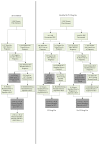Risk-Based Prenatal Hepatitis C Testing Practices and Results, Alaska 2013-2016
- PMID: 31275902
- PMCID: PMC6582887
- DOI: 10.1155/2019/8654741
Risk-Based Prenatal Hepatitis C Testing Practices and Results, Alaska 2013-2016
Abstract
Hepatitis C virus (HCV) infection in pregnant women is of concern as it presents a health threat not only to the mother, but also to her infant. A retrospective analysis was performed to evaluate HCV testing and exposure in women who delivered infants between 2013 and 2016 at a referral hospital in Alaska. Multiple risk behaviors were evaluated, including drug dependency or abuse (drug abuse), tobacco use, alcohol dependency or abuse, and late presentation to prenatal care. Of the 2856 women who delivered between 2013 and 2016, 470 (16.5%) were tested for HCV during pregnancy and 1356 (47.5%) were tested at any time prior to delivery (including pregnancy); 62 (2.2%) were positive for HCV antibodies. Of the 162 women with a documented history of drug abuse, 95 (58.6%) were tested for HCV during pregnancy and 143 (88.3%) were tested at any time prior to delivery (including pregnancy); 30 (18.5%) were positive for HCV antibodies. Forty-nine women (34%) with a documented history of drug abuse who were not previously known to be HCV positive were not tested for HCV during their pregnancy. In conclusion, approximately 2% of pregnant women in the study population were known to have been exposed to HCV by the time of their delivery. One-third of women with documented drug abuse did not have an HCV test during pregnancy, revealing gaps in HCV testing of pregnant women. Further studies are needed to understand the full costs and benefits of risk-based screening versus universal screening in this and other populations.
Figures
References
-
- Garcia-Tejedor A., Maiques-Montesinos V., Diago-Almela V. J., et al. Risk factors for vertical transmission of hepatitis C virus: A single center experience with 710 HCV-infected mothers. European Journal of Obstetrics & Gynecology and Reproductive Biology. 2015;194:173–177. doi: 10.1016/j.ejogrb.2015.09.009. - DOI - PubMed
-
- Smith B. D., Morgan R. L., Beckett G. A. Recommendations for the identification of chronic hepatitis C virus infection among persons born during 1945–1965. MMWR: Recommendations and Reports. 2012;61(RR-4):1–32. - PubMed
Publication types
MeSH terms
LinkOut - more resources
Full Text Sources
Medical


